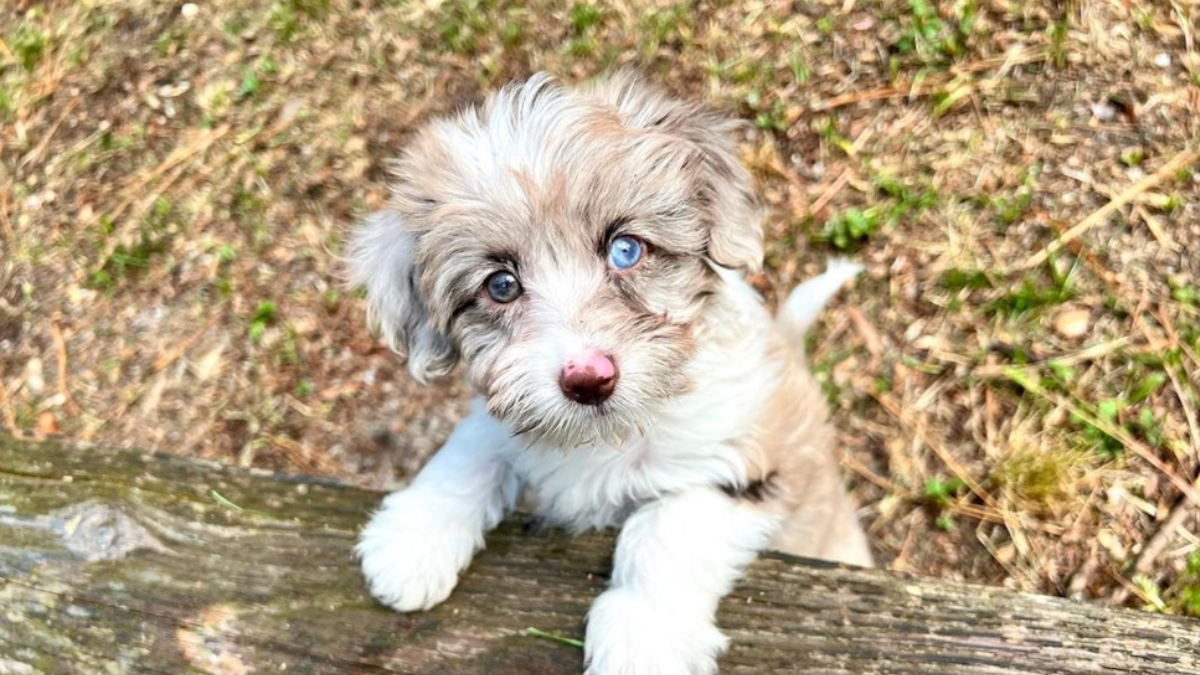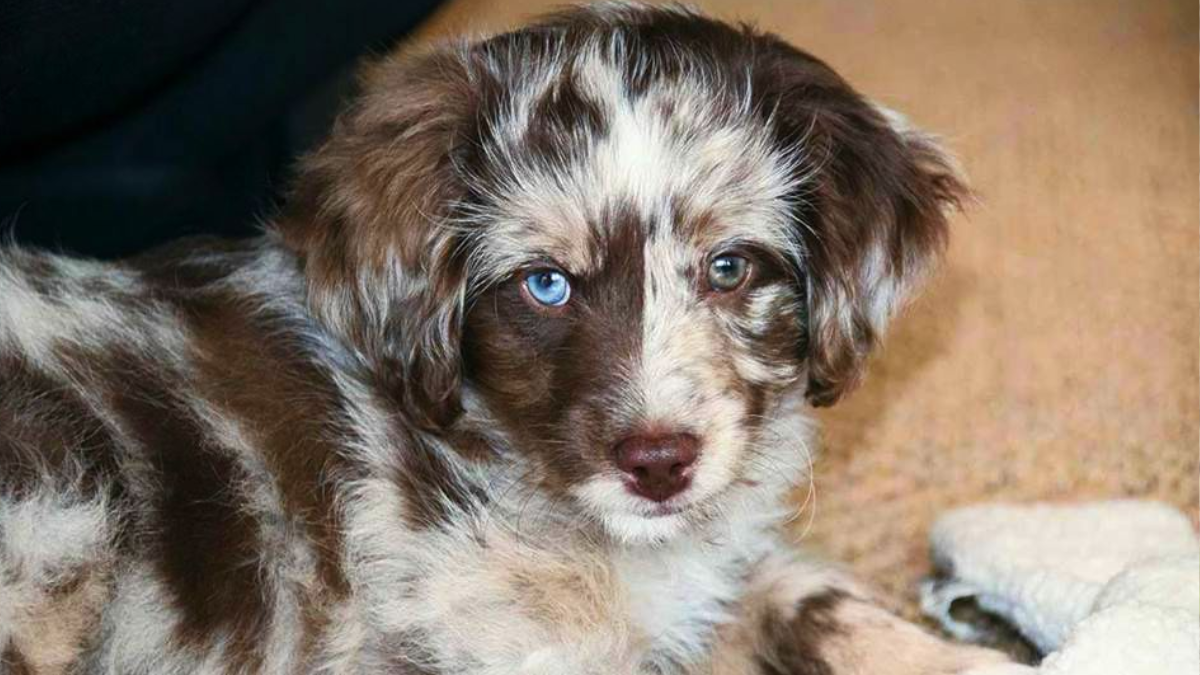The Mini Aussiedoodle is a mixed breed dog, a cross between the Miniature Australian Shepherd and the Miniature Poodle. Earning the title of a "designer dog," this hybrid manages to encapsulate the intelligence and agility of both parent breeds. Renowned for their small stature and hypoallergenic coats, Mini Aussiedoodles make a perfect fit for families and individuals seeking a spirited and affectionate companion.
Known for their sociability and adaptability, Mini Aussiedoodles thrive in various living environments, whether it is a spacious suburban home or a compact city apartment. Their high energy levels and eagerness to please make them excellent candidates for a wide array of activities, from dog sports to therapeutic work. The breed's intelligence inherited from both the Australian Shepherd and the Poodle allows for relatively easy training, making these dogs ideal companions for both novice and experienced dog owners alike.

Stay Connected and Secure with the Fi Dog Collar
When raising a Mini Aussiedoodle, ensuring their safety and managing their high energy levels are paramount. Equip your playful companion with the Fi Dog Collar to enhance your peace of mind. Designed with precision GPS tracking, the Fi Dog Collar allows you to keep tabs on your Mini Aussiedoodle's location in real time, whether they're playing in the backyard or adventuring in the park. Its built-in activity monitor also ensures your pet is getting enough physical activity to stay healthy and happy.
Robust, comfortable, and easy to use, the Fi Dog Collar is more than just a collar—it's an essential part of your journey with your Mini Aussiedoodle, providing safety and ensuring they remain by your side. Embrace the confidence that comes with knowing your pet is safe, and focus more on enjoying the moments that matter.
Breed Overview
The Mini Aussiedoodle, also known as the Mini Aussiepoo, combines the intelligence and energy of the Australian Shepherd with the hypoallergenic coat of the Poodle.
Origin and History
The Mini Aussiedoodle is a designer crossbreed between the Miniature Australian Shepherd and a Miniature Poodle. Developed in the late 20th century, breeders aimed to create a hypoallergenic dog with the smart, work-oriented traits of the Australian Shepherd and the Poodle's non-shedding coat.
Characteristics
This crossbreed is known for its intelligence, affectionate nature, and high level of energy that makes for an excellent active companion. Mini Aussiedoodles are versatile in both their abilities and adaptability, thriving in various living environments as long as they receive enough exercise and mental stimulation.

Size and Weight
Adult Mini Aussiedoodles typically weigh 15 to 35 pounds. The precise size can vary depending on the traits inherited from the parent breeds, with some leaning towards the smaller size of the Miniature Australian Shepherd or the slightly larger frame of the Miniature Poodle.
Coat Colors and Types
Their coats can vary but often manifest in a soft, sometimes curly texture that combines attributes from both parent breeds. Common coat colors include:
- Black
- Red
- Cream
- Brown
- White
- Blue Merle
- Red Merle
The hypoallergenic quality of the coat makes the Mini Aussiedoodle a desirable choice for individuals with allergies. Regular grooming is necessary to maintain the health and appearance of their coat.
Care and Management
Proper care and management of a Mini Aussiedoodle encompass a balanced diet, regular exercise, diligent grooming, and structured training and socialization. These dogs are intelligent, have high energy levels, and can develop behavioral problems if not managed correctly. Adherence to these care principles is essential for their health and well-being.

Feeding and Diet
The Mini Aussiedoodle requires a diet rich in protein to support its energy needs.
- Puppies (under 1 year): 3 to 4 meals a day
- Adults (1 year and older): 2 meals a day
Use high-quality dog food that meets the following criteria:
| Age Group | Protein Content | Food Type |
|---|---|---|
| Puppies | At least 22% | Puppy-specific food |
| Adults | At least 18% | Adult dog food |
Treats should be given sparingly to avoid weight gain.
Exercise Needs
Mini Aussiedoodles are energetic and require daily exercise to maintain their health.
- At least 30 to 60 minutes of exercise per day
- Activities could include walks, playtime, or agility training
Their exercise needs can be broken down into two main types:
- Physical Exercise: Walking, running, dog sports.
- Mental Stimulation: Puzzle toys, training exercises.
Grooming Requirements
They possess a hypoallergenic coat that necessitates regular grooming.
- Brushing: At least 3 times a week to prevent matting
- Bathing: Once a month or as needed
Professional grooming should occur every 6 to 8 weeks to maintain coat length and health.
Training and Socialization
Training should begin early to foster good behavior.
- Start early socialization and training during puppyhood
- Consistent training sessions emphasizing positive reinforcement
- Intelligence allows for complex commands and tricks to be learned
Well-trained Mini Aussiedoodles tend to exhibit fewer behavioral problems. Establish a routine that includes opportunities for socialization with other dogs and people.

Health and Temperament
The Mini Aussiedoodle is a crossbreed known for its generally good health and amiable temperament. However, potential owners should be aware of certain health issues that can affect the breed and understand the behavioral characteristics that make them such beloved companions.
Common Health Issues
The Mini Aussiedoodle can be prone to a variety of health concerns, often inherited from their Australian Shepherd and Poodle ancestors. It's essential for owners to monitor their pets for signs of the following conditions:
| Health Issue | Description |
|---|---|
| Hip Dysplasia | A malformation of the hip joint that can cause pain and arthritis. |
| Epilepsy | A neurological disorder that can cause seizures. |
| Cataracts | Opacity in the lens of the eye, leading to impaired vision. |
| Hypothyroidism | An underactive thyroid gland resulting in various metabolic problems. |
| Progressive Retinal Atrophy | Degeneration of the retina, which could lead to blindness. |
| Ear Infections | Due to their floppy ears, they can be susceptible to infections. |
Regular veterinary check-ups and a nutritious diet can help manage and prevent some of these issues. Pain associated with conditions like hip dysplasia can often be managed with the help of a veterinarian.
Temperament and Behavior
The temperament of the Mini Aussiedoodle is typically:
- Friendly: They generally get along well with other pets and humans.
- Loyal: They are known for their strong attachment to their families.
- Playful: An energetic breed that loves to play and needs regular exercise.
- Intelligent: Highly trainable due to their sharp intellect.
- Loving: They often show affection to their owners and enjoy being part of family activities.

Early socialization is crucial for the Mini Aussiedoodle to develop a well-rounded temperament. Exposure to different people, pets, and environments can help prevent the development of shyness or aggression. A confident Mini Aussiedoodle is usually a happy and well-adjusted companion.
Adoption and Breeders
When considering adding a Mini Aussiedoodle to your family, it is crucial to evaluate both breeder and adoption avenues to ensure you are making an informed decision that supports the well-being of these mixed-breed dogs.
Choosing a Reputable Breeder
Characteristics of a reputable breeder:
- Health Testing: They should perform genetic health testing on their breeding stock to minimize health issues in Mini Aussiedoodle puppies.
- Transparency: A reputable breeder is transparent about their breeding practices and is willing to provide thorough records and meet in person.
To spot a reputable breeder:
- Ensure they are recognized by reputable organizations, like the American Kennel Club (AKC), even though the Mini Aussiedoodle is not an AKC-recognized breed due to its mixed breed status.
- They should prioritize the health and temperaments of their dogs and not merely the popularity or aesthetic traits of Mini Aussiedoodles.

Adoption Options
Adoption avenues include:
- Rescue groups: Many rescue organizations specialize in poodle mixes and might occasionally have Mini Aussiedoodles.
- Shelters: Local animal shelters sometimes have mixed breed dogs available for adoption, where one might find a Mini Aussiedoodle.
Before adoption, consider:
- Shelters provide necessary vaccinations and often spay/neuter the dogs.
- Adopting a Mini Aussiedoodle supports the welfare of dogs in need and is typically more cost-effective than purchasing from a breeder.
Conclusion:
In conclusion, Mini Aussiedoodle brings boundless joy to any home. Their playful spirit and unwavering loyalty make them cherished family members. From their intelligence to their affectionate nature, they embody the best qualities of both breeds. Welcoming a Mini Aussiedoodle into your life means opening your heart to endless love and companionship. With their adorable faces and loving personalities, these pups are sure to bring happiness to every moment.




